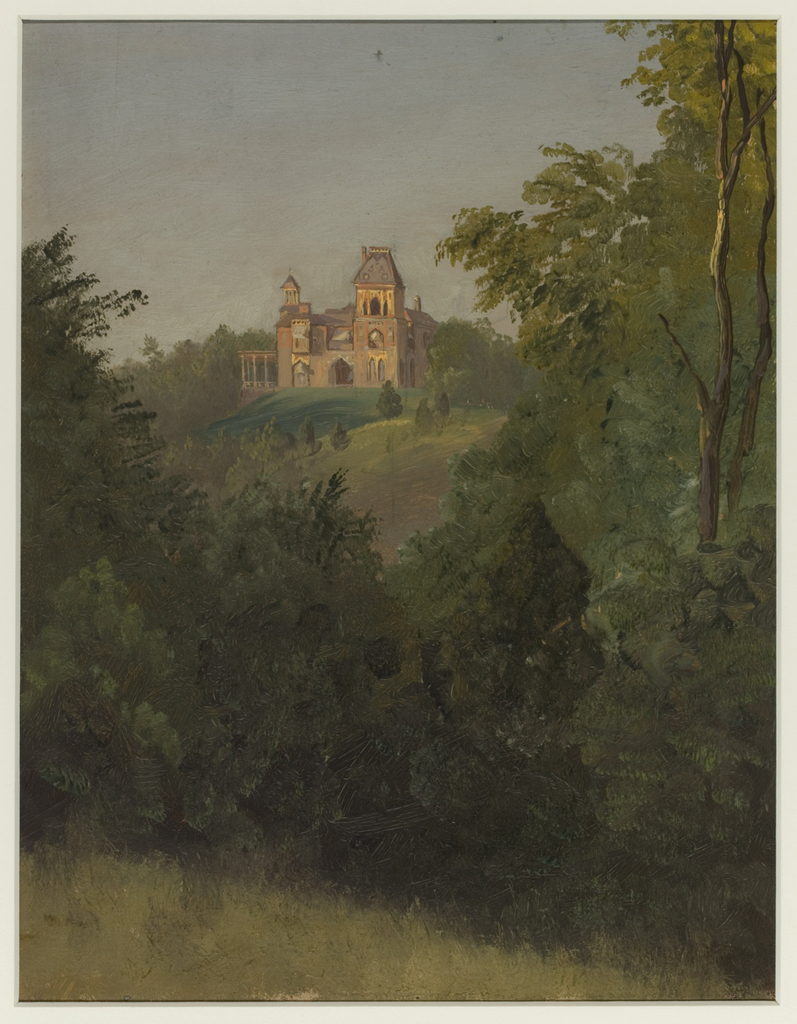This view of Frederic Edwin Church’s home Olana outside Hudson, New York is one of 2,035 oil sketches and graphite drawings by Church in Cooper-Hewitt’s collections. The Church archive represents the largest collection of the artist’s works on paper in the world! Church was one of the most prominent figures in the Hudson River School, the only student of the movement’s founder Thomas Cole. Church’s breathtaking and luminous depictions of landscapes both in America and abroad have earned him the status as one of the most beloved artists in American history.
The Museum is often asked how this treasure of Church objects came to Cooper-Hewitt. While we are still to this day searching for some of the details, we do have much of the information. The acquisition of this remarkable gift was the work of two key players. The first, Charles Worthington Gould (1849-1931), was a prominent New York attorney and a member of both the Cooper Union Board and of the Museum’s Advisory Council. In addition to supporting the Museum financially and through donations of objects, books, and drawings to the collections, Gould was himself a painter, and he took lessons from a painter named Eliot Clark. Clark came from a comfortable, socially connected New York family. A precocious talent, he followed his father Walter Clark into the field of landscape painting. Working together, Clark and Gould secured some key donations of American works for the Cooper Union Museum between 1916 and 1920.
In the spring of 1916, Clark found out from a painter friend of his that an archive of Church paintings and drawings remained at Olana with Church’s younger son, Louis Palmer Church. Clark then got in touch with Louis Church, who invited him to meet at Olana. Church devoted much of his later life to the design of his stunning home and gardens, looking out over the Hudson River, which he lovingly rendered in oil in the sketch depicted above. It would have been an inspired spot for Clark to sit and review the drawings and oil sketches. Over a two day period in November 1916, Clark made his preliminary selections of works for Cooper Union Museum, and a few weeks later he returned with Charles Gould. In total, they selected 514 oil sketches and 1521 graphite drawings (in forty-seven sketchbooks and 492 loose sheets).
The majority of drawings and oil sketches that Clark and Gould selected date from the 1850s and 1860s, when Church’s technical proficiency was most dazzling. Their choices included dramatic representations of Ecuador and Columbia (1853 and 1857); Niagara Falls (1856 and 1858); Newfoundland and Labrador (1859); Jamaica (1865); the Holy Land, Europe, and Greece (1868-1869); and Mount Katahdin (1870s and early 1880s). After the gift arrived in New York City, some of the material was exhibited in the Hewitt Lexington Avenue home at the April 1917 reception of the Museum Council. Frederic Delano Weekes, secretary to the Council reported that sketches and studies were “of such beauty that they compelled the admiration of all.” That sentiment remains today; works from the Church archive are among the most popular objects in Cooper-Hewitt’s collections.
Today is Frederic Edwin Church’s birthday.
You can find Cooper-Hewitt’s catalogue Frederic Church, Winslow Homer, and Thomas Moran: Tourism and the American Landscape at shop.cooperhewitt.org
